A simple Google search on ‘Women in Early India’ will land you with a number of articles each explaining how great women had it back in those days. It is said that women ‘enjoyed a high status’ and were equal to men in all aspects of life.
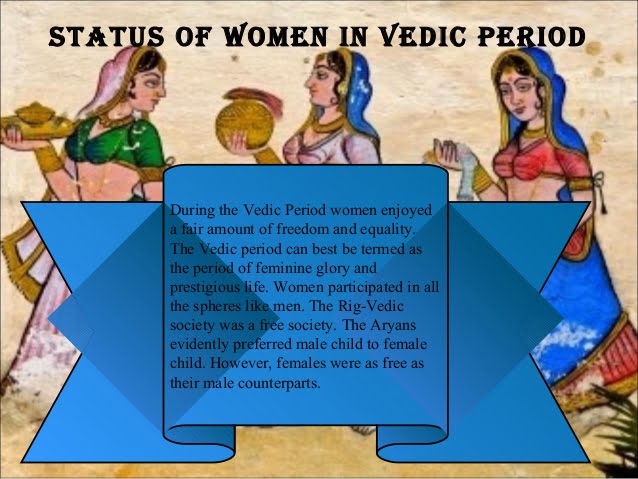
Image Source: Slide Share
We are told how goddesses had separate temples for them, and were allowed to choose partners, perform sacrifices with their husbands. The story of Gargi engaging in a philosophical debate with the King Yajnavalkya is given as an indisputable example of how women had access to education. Their status is judged primarily on basis of their relationship to men and their familial roles.
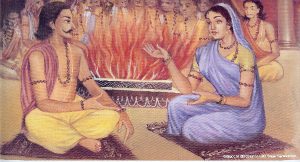
Gargi in a debate with the King Yajnavalkya. Image Source: Shells,Tales and Sails
While the Vedic period (2000-500 BCE) is seen specifically as a ‘Golden age’ for women, there are also sweeping generalisations regarding the celebrated position of women during all of ancient Indian period.
The questions we need to ask are: Did women in early India really have a high status? Which category of ‘women’ are we even talking about? Who are these people who’ve made such claims and why do these claims carry such great importance in our own times?
Let’s try and break down some of these arguments which say women had an enviable position during the ‘Golden Vedic age’:
1. Goddesses were worshipped: There was no easy or automatic translation of goddess worship into actual changes for real women. The only thing that can be concluded from this is that divinity could be imagined in a feminine form by the people. We definitely cannot jump to the result that all women enjoyed political power and prestige just because we find evidence of goddess worship in this period.
2. Rig Veda has hymns composed by women and women sages existed: Out of over 1,000 hymns in the Rig Veda, only 12-15 are attributed to women. Clearly, this is not much cause for celebration. What this suggests is that women had limited access to sacred learning.
3. Women also performed sacrifices: Women were allowed to perform sacrifices on behalf of their husbands, but never in their own right. A true marker of political privilege could be if they were the givers or receivers of dana or dakshina (booty from cattle raid). However, they don’t appear to be in such roles.
Also Read: The Paradox Of Hindu Goddess Worship And Feminism
What needs to be noted here is that patriarchy and oppression of women have existed in all periods of history, the question is what the extent of this oppression was.
Due to the patriarchal and patrilineal nature of the household in Vedic times, women were denied access to resources. Control over their sexuality was exercised and maintained through establishing norms of acceptable behavior.
In fact, for the later Vedic period during 800 BCE – 400 BCE, the historian Kumkum Roy argues how rituals conducted in the household were important to validate the control the male patriarch had over material resources and the reproductive role of women.
Due to the emergence of the state (rajya), the king assumed the role of the protector of the social order. He gained control over coercive power (danda), chariots etc. This display of power inspired the ordinary householder to exercise control over women and the performance of rituals was one of the ways to achieve that. Women were therefore seen as property, either gifted away to priests or to others in marriage.
patriarchy and oppression of women have existed in all periods of history, the question is what the extent of this oppression was.
Moreover, these popular and easily available views have 180 years of dialogue and discussions behind them. They have been strongly influenced, shaped and informed by oppressive ideas disseminated by privileged men. They have a history and politics of their own, which shows that these are not given ‘facts of history’ which we can accept uncritically.
This begins with how colonial historians looked at India and how in reaction to a hostile view of India, nationalist historians invalidated their arguments.
Racist colonial historians looked for values of modernity and scientific rationale in a society. When they saw that India lacked these qualities, it was criticized severely. Historians such as Vincent Smith condemned everything associated with India. Some features, such as Indian art, which was undeniably worthy of consideration was attributed to Greek influence, thus denying it any possibility of indigenous roots.
This was hence an extremely Eurocentric view which sought to justify the colonization of a people by showing them as inferior. In response to the hurt inflicted by colonial historians on the upper caste Hindu sense of superiority, nationalist historians tried to present a ‘glorious Indian past’. They didn’t question the stereotypes created by British historians and instead indulged in unashamed glorification of Indian past.
An important part of this effort was through showing how in ancient India, unlike other places in the world, women were treated well. The ‘woman question’ was taken up first in the early years of nationalist movement by social reformers like Raja Ram Mohan Roy. The socio-religious movement looked back to ancient texts to argue for reforms within Hinduism.
Due to the fact that this question was analysed solely within the context of Hinduism,the status of women was judged solely in legal and religious terms, and studied mainly from religious texts of the Brahmanical tradition. Legal matters like right to property, institutions of stridhana (gifts given to women before and after marriage) and niyoga (practice of marrying off a widow to her brother-in-law) and religious affairs like performance of sacrifices became important in the debates around status of women.
An important part of the nationalist effort went towards showing how in ancient India, unlike other places in the world, women were treated well.
These Brahmanical texts, used by the religious reformers and even their opponents, were compiled and transmitted by Brahmins. Therefore, these texts carried their inherent bias, were unreflective of realities of ordinary people and restricted to upper castes – what they provided was only an incomplete view from the standpoint of privileged men.
Hence, our current obsession to celebrate the respectable position of women based on their role in family and marriage goes back to the 19th century nationalist struggle. Not only are these criterion of progress flimsy and selective but also extremely simplistic. These are ideas based on unreliable sources which were churned out by upper caste men belonging to middle class section of society.
In nationalist historiography, the patriarchal construction of this category of ‘woman’ was accompanied by alienation of an entire community. The view that women enjoyed privileges and freedoms was established by creating Muslims as outsiders and barbaric invaders.
Hinduism in its Sanskritic form was seen as the essential culture of India. This is seen in how Gupta period, because it experienced a high volume of the production of Sanskrit literature, was seen as the ‘Golden period’ of ‘Hindu’ India as it was believed that during this time that Hinduism became popular again. Other cultures were seen as intrusions and very often the coming of Muslims in India was held responsible for problems plaguing the Indian society.
This was the case for the Hindu woman as well. She was said to have been held in high regard in pre-Islamic times until the Muslim invasions took place. The social evils of sati and child marriage hence grew in a response to the ‘atrocities’ inflicted by the Muslims. Self immolation of a widow was preferred to save her from foreigners.
Also Read: We Need To Stop Viewing Women As The Flag-Bearers Of Nationalism
These are not dead ideas which hold no relevance in our times. Islamophobic comments by Atul Kochchar and movies like Padmavaat reinforce the same ideas of Muslims despoiling Hindu women with their ‘savagery’. This continues to tangibly harm people and add to the ways talk about Muslims in our everyday lives.
One of the most dangerous aspects of this kind of a view is its tendency to generalise. These are essentially histories of upper caste women situated in the Gangetic plain. This history which has now become almost unquestionable is, by default, upper caste and North Indian – even as it claims to be representing ‘all women’.
The view that women enjoyed privileges and freedoms was established by creating Muslims as outsiders and barbaric invaders.
So, where did the lower caste women figure in the nationalists’ fixation over the history of upper caste Aryan women? According to one nationalist historian, A.S Altekar, it was because of the Shudra woman that all women were denied access to Vedic learning. The introduction of the Shudra wife in an Aryan household meant that the husband started preferring her over his Aryan wife for performance of rituals. Because of the non-Aryan wife’s ‘ignorance of Sanskrit language and Hindu religion’ (Altekar 1959), Altekar speculated this must’ve led to some faults while performing rituals. The failure of the Shudra wife must’ve convinced men that all women are incompetent and hence not worthy of receiving education.
These are casteist, racist views of historians informed by popular prejudices. The history of non-upper caste women is treated as trivial and unimportant. We find glimpses of oppression of non-upper caste women in the context of how during the Rig Vedic period, there was a constant struggle between the Aryans and ‘indigenous’ tribes. The latter were seen as ‘inferior’ by the Aryans for their dark skins and were approached with hostility. The Aryans were successful in ‘conquering’ over some and hence enslaved the women of the conquered people. There was hence a hierarchy and division between women of conquering people and women of subjugated people.
These ideas formulated in the 19th and 20th centuries have managed to persist in people’s imaginations. Not only do they provide an inaccurate picture of gender relations in early India but also an instance of how history is weaponised to marginalise certain communities. The compartmentalisation of ancient history as ‘Hindu’ history is to deny marginalised communities a space in historical memory and negate their contributions and presence.
The current insistence on a glorified Indian past where the upper caste woman enjoyed rights is created only through exclusion of lower caste women and demonisation of Muslims. These are not ‘neutral facts’ of history but strategic views meant to feed into narrative of hate and exclusion against Dalits, Muslims and women.
The insistence on a glorified past where the upper caste woman enjoyed rights is created only through exclusion of lower caste women and demonisation of Muslims.
Early Indian history is marked by violence, tensions between communities and fluidity of communication. It is a messy period which defies simplifications and over generalisations. It is time we rethink and question not only about the history of gender in early India but also about how we come to learn about these histories.
References
- Jha, D.N, How Hindutva Historiography is Rooted in the Colonial View of Indian History, The Wire.
- Chakravart, Uma, ‘Beyond The Altekarian Paradigm:Towards a New Understanding of Gender Relations in Early Indian History’, Social Scientist, Vol. 16, No. 8 (Aug., 1988), pp. 44-52
- Chakravrti, Uma,’Conceptualising Brahmanical Patriarchy in Early India: Gender, Caste, Class and State’, Economic and Political Weekly, Vol. 28, No. 14 (Apr. 3, 1993), pp. 579-585
- Roy, K. Power of Gender and Gender of Power: Explorations in Early India. New Delhi: Oxford University Press, 2010
Featured Image: Slide Share
About the author(s)
Umara is pursuing her bachelors in history from St.Stephen’s college. Feminism to her is an evolving process, she doesn’t feel the need to define her version of it, because she comes from the belief of autonomy of the oppressed classes.
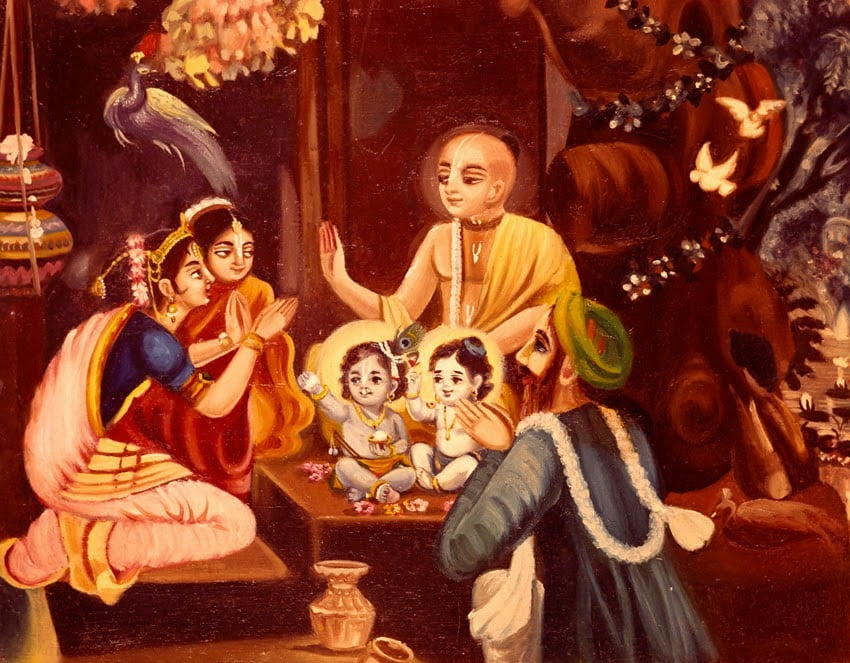
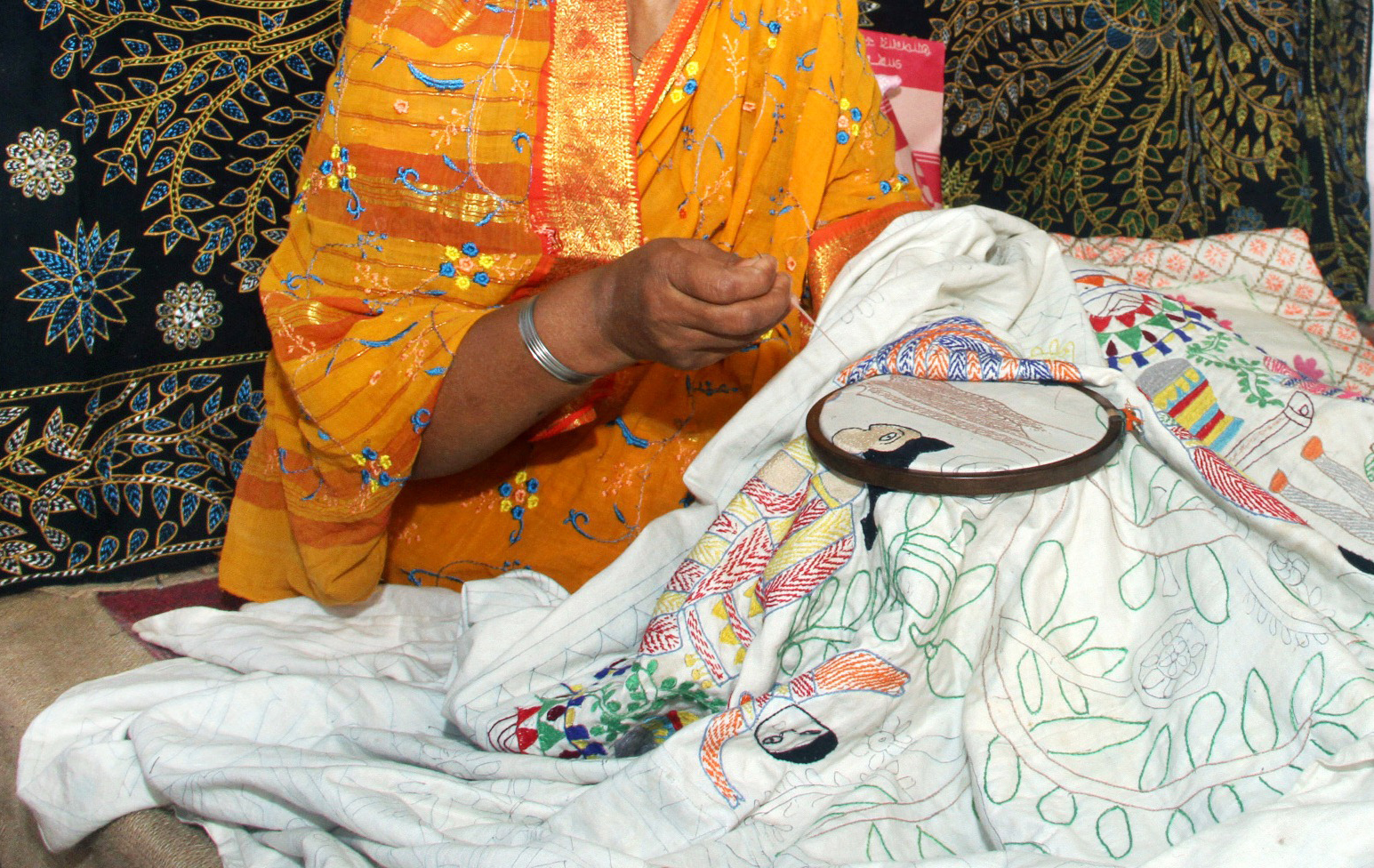
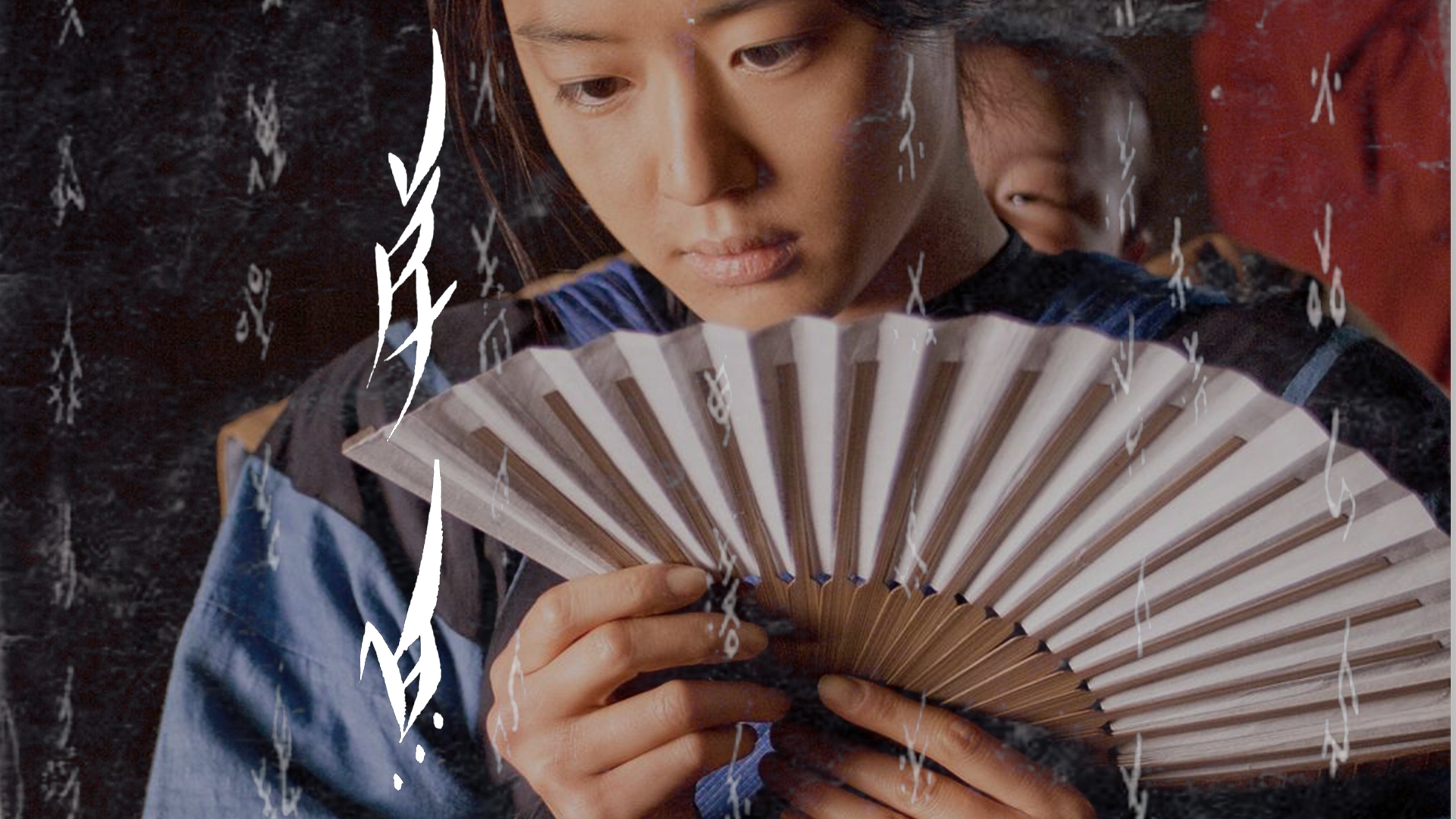


Bravo! In the country when one is so attached to the traditional culture we need to debunk myth about high position of a woman in that society in the past! We need to show everyone that feminism has nothing to do with India. We need to show that feminism is an absolutely alien concept to India. We need to show that there are absolutely no basis for feminist ideology in the traditional indian culture. We need to show that we are against this culture. The question arises, do we have a rational thinking at all? When we do something, do we care about result?
Hello you should also check these articles
Arab women before and after Islam: Opening the door of pre-Islamic Arabian history
http://abdullahsameer.com/blog/arab-women-before-and-after-islam-opening-the-door-of-pre-islamic-arabian-history/
Women, the Inferior Species in Islam
http://abdullahsameer.com/blog/women-the-inferior-species-in-islam/
To understand this ,check this
A Feminist from the 19th Century –Swami Vivekananda
https://www.womensweb.in/2013/01/a-feminist-from-the-19th-century-vivekananda/
you can not defend Muslims …….they were invaders and now they are religious invaders
Umm one thing still stays, like very few women, those considered ‘upper-caste’ ones were allowed in the early vedic to read vedic scripts, was that even abolished in the later vedic period, such that the statement “women were denied right to study vedic texts” stands, and if it happened than why and how, and if not than what’s the meaning of this statement arising? if it’s just a nationalist fixation, than also how?
Can u please please answer me ..
I am expecting an answer from someone anbody